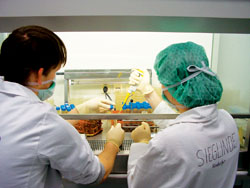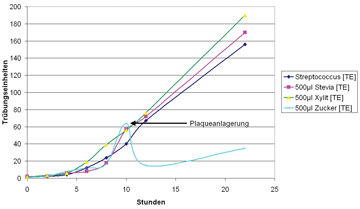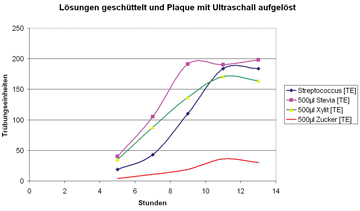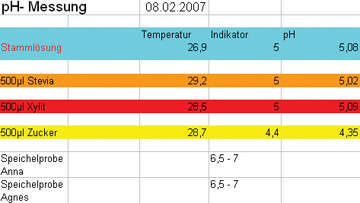Streptococcus mutans is considered to be the major cause of tooth decay. Through dentifrices and by avoiding sweets people try to control the growth of this bacterium.
Various authors on the web claim without sufficient scientific proof that Stevia inhibits caries. Browsing through all of our research data bases, we could not find any related scientific articles.
This is how we came up with the idea to proof Stevia’s caries-inhibiting property by ourselves.
We speculated that stevioside decelerates or even impedes the reproduction of the bacteria.
Some brave students decided to girdle themselves for the battle against the dangerous organism causing caries. Our weapon of choice: Stevia rebaudiana.
As with any battle of significance, this one did not go off without a hitch and we had to bear several challenges and ordeals. Challenges that needed to be met with creativity and teamwork. |
 |
| Quite a special feeling- to calculate the amount needed to “feed” a germ! |
Challenge 1
Where to get Streptococcus mutans from?
To extract the bacterium from our own mouths occurred to us too imprecise as a high-quality study requires very pure and large amounts of bacteria were purchased. The bacterial cultures from the „Deutschen Sammlung von Mikroorganismen und Zellkulturen GmbH“. As Streptococcus mutans is classified as risk group 2, several safety precautions had to be met.
Definition “risk group 2“: Dangerous biological substances that might afflict disease in humans and threaten employees; a spread among the population is unlikely; effective prophylaxis and treatment is possible.
During our careful work at the sterile hood the use of sterile rubber gloves, face masks and laboratory coats had top priority. Every tool had to be sterilized or disinfected, every piece of waste had to be autoclaved. Mr Gerold Sigl explained the theory of these procedures and supervised our practical work as well.
We passed the first test – the enemy was among us and under our control.
Challenge 2
How to measure the reproduction of Streptococcus?
In order to obtain comparable data we fed Streptococcus with stevioside, but also with other sweeteners. As widely known, sugar is the best source of food for caries. For the initial test series we used saccharine, later we used glucose.
|
|
Plaque formation with sugar
|
The microscope shows: No plaque formation with Stevia
|
To check our results we also used xylite, a sweetener that has already been commercialized and which is known to inhibit caries and therefore widely used in chewing gum.
Xylite occurs naturally in several kinds of vegetables, fruit and in the bark of certain wood species. It is industrially produced by a chemical modification of xylene from the sugar xylose. This kind of production is very costly and makes xylite a comparably expensive substitute for sugar. Nowadays it is extracted from corncobs after the corn is removed. The human liver, while digesting carbohydrate, produces 5 to 15g each day.
Xylite has the same strength and taste as sugar while containing only 50 % of the calories (10 kJ/g). The metabolism of xylite in humans is independent from insulin and hardly influences the levels of glucose or insulin in the blood, hence, it is suitable for diabetics. Xylite is reabsorbed passively and slowly by the intestinal mucosa. (http://de.wikipedia.org/wiki/Xylit) We were hoping that Streptococcus mutans would grow slower by adding Stevia and xylite than by adding sugar. Population growth of these samples was expected to vary a great deal, hence it was planned to be visualized in graphs. In order to obtain the data necessary for such a graph we measured the reproduction of Streptococcus every hour. But another problem arose: How could we measure the growth of population of such a tiny living organism? The photometer turned out to be the solution of this problem.
This device measured the number of bacteria – dead or alive – via measuring the amount of light going through (or being absorbed) by the culture in the test tubes. We used a blank sample as point of reference which consisted solely of the nutrient solution and a calibrated amount of Streptococci. Then, we could measure the samples with the streptococcus and the various sweeteners in order to obtain comparable data on its rate of growth.
We passed the second test! Now we were ready to lead off the fight!
Challenge 3
The germs try to evade measuring!
In order to find a suitable medium for the bacteria, we tried to calculate a concentration of sugar that would taste comparable to the aftertaste of e.g. chocolate. As stevioside is far stronger than sugar or xylite, we had to calculate the exact ratio of sugar, Stevia and xylite. After turning this issue over our minds for some time, we decided to determine the ratio using our own taste buds. We put 5µl, 50µl and 500µl of the stock solution into different test tubes to attain three different dilutions. We added 100µl of Streptococci, stock solution and standard nutrient solution (the bacteria continue to feed on other nutrients, salts and micronutrients etc as well). The samples were then put into the incubator at 37°C. After about 4 hours we carried out the first measurements using the photometer. We continued to measure the samples every after hour.
But our results were totally different from what we had expected! After the first measurements we realized that the bacteria were growing at the same rate in all the different samples.
| The only variance we could observe was between the different levels of dilution. We know now that the dilution with 5µl and 50µl of stock solution resulted in a too low concentration of food. This was the case with xylite as well as with stevioside or sugar. After some time, the measured data of only the sugar samples started to decrease plummet?? Kenn I net, indicating that the bacteria were already becoming less. This was unexpected, because the bacteria couldn’t possibly have left the test tube. After thinking over the problem for some time, we realized that some kind of biofilm had evolved on the rims of these tubes: Streptococcus mutans had started to form plaque as it is expected to do in our mouths. (see Graph 1) |
|
The way to the top
is paved with banana skins…
|
|
Desperately we tried to come up with a solution until our heads were spinning. We were hoping to impede plaque formation by putting the tubes into shaking baths – without success. Unwilling to give up, we tackled the plaque with an ultrasound scanner and vortexed the sample in order to get the bacteria in solution again. This strategy made it possible to continue with the measurements.
|
| …but with a little help from your friends one can face any type of challenge. |
We were quite disappointed to learn that the bacteria were growing more or less at the same rate in all three samples. (see Graph 2) Were our samples contaminated with other bacteria which had started to outgrow Streptococcus mutans?
Using PCR we nonetheless identified the bacteria to be our cariogenic enemy that continued to thrive in all the samples.
Had our hypothesis been wrong? Why was the germ multiplying in the sample with xylite which has proved to hamper caries? What was our mistake?
Challenge 4
Where did the plaque come from?
According to the „Deutsche Sammlung von Mikroorganismen und Zellkulturen GmbH“ Streptococcus m. needs a neutral environment (pH 7). This lead us to measure the pH-value of the samples. We found out that the pH-value had decreased to pH 4 in the sugar samples. In the Stevia and xylite samples it had remained above pH 5 (see table of pH values)
The metabolites of Streptococcus mutans are acidic and decrease the pH-value in the tube.
Once the pH-value of 4 to 5 has been reached it starts to form the biofilm; the cells start to adhere to each other and cover teeth, or, in our case, the rims of the tubes. |
Graph 1: |

Graph 2:

|
 |
We realized that we had drawn the wrong conclusions, that the hypothesis had been wrong and that we needed to reconsider the meaning of our results. Stevia as well as xylite hemper not only the multiplication of Streptococcus mutans, but also the formation of plaque. It is the plaque that is dangerous for our teeth as it provides an opportunity for the bacteria to agglomerate. The consequences are cavities and tooth decay. If Streptococcus m. doesn’t get a chance to form plaque, as is the case with stevioside and xylite, it is rendered harmless as it remains moving freely in the oral cavity. Streptococcus m. is prevented from producing acidic metabolites when fed with stevioside and xylite. Consequently, no plaque formation takeing place and the teeth remain healthy. (see page 17, microscopic pictures of sugar and Stevia) |
This knowledge is applied by the producers of tooth care chewing gums which regulate the pH-value at pH 7.
Finally, we had to verify our results to make sure that they could not be ascribed to chance.
|
|
Friendship, fellowship
and a common end in view.
|
|
After our initial hypothesis had turned out to be wrong, the team was the happier to have attained interesting and convincing results.
Stevioside hempers the formation of plaque and, hence, protects teeth from caries.
We had stood our ground! The enemy had to admit defeat and we had lifted his secret… |
Plaque and no plaque…
we’ve found the solution!
|
|
